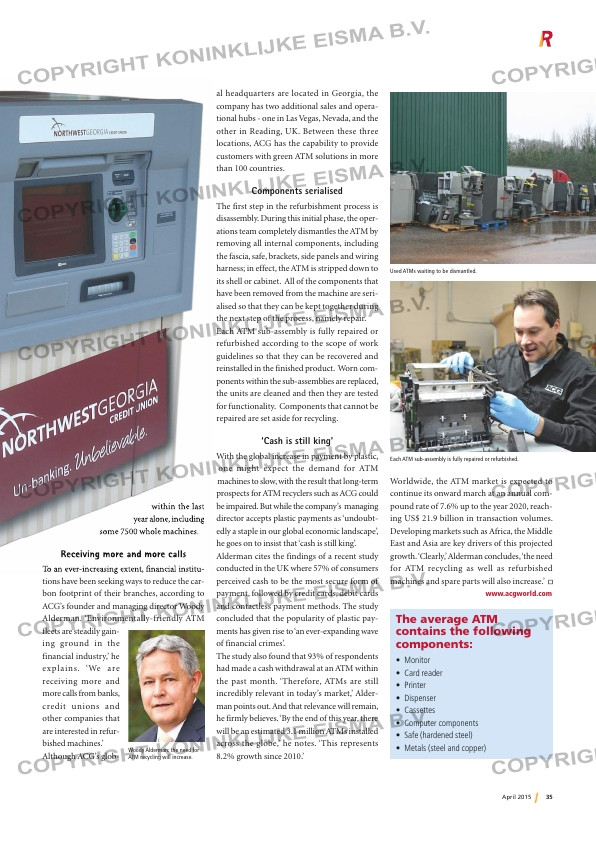Page 35 from: April 2015

35April 2015
within the last
year alone, including
some 7500 whole machines.
Receiving more and more calls
To an ever-increasing extent, financial institu-
tions have been seeking ways to reduce the car-
bon footprint of their branches, according to
ACG’s founder and managing director Woody
Alderman. ‘Environmentally-friendly ATM
fleets are steadily gain-
ing ground in the
financial industry,’ he
explains. ‘We are
receiving more and
more calls from banks,
credit unions and
other companies that
are interested in refur-
bished machines.’
Although ACG’s glob-
al headquarters are located in Georgia, the
company has two additional sales and opera-
tional hubs – one in Las Vegas, Nevada, and the
other in Reading, UK. Between these three
locations, ACG has the capability to provide
customers with green ATM solutions in more
than 100 countries.
Components serialised
The first step in the refurbishment process is
disassembly. During this initial phase, the oper-
ations team completely dismantles the ATM by
removing all internal components, including
the fascia, safe, brackets, side panels and wiring
harness; in effect, the ATM is stripped down to
its shell or cabinet. All of the components that
have been removed from the machine are seri-
alised so that they can be kept together during
the next step of the process, namely repair.
Each ATM sub-assembly is fully repaired or
refurbished according to the scope of work
guidelines so that they can be recovered and
reinstalled in the finished product. Worn com-
ponents within the sub-assemblies are replaced,
the units are cleaned and then they are tested
for functionality. Components that cannot be
repaired are set aside for recycling.
‘Cash is still king’
With the global increase in payment by plastic,
one might expect the demand for ATM
machines to slow, with the result that long-term
prospects for ATM recyclers such as ACG could
be impaired. But while the company’s managing
director accepts plastic payments as ‘undoubt-
edly a staple in our global economic landscape’,
he goes on to insist that ‘cash is still king’.
Alderman cites the findings of a recent study
conducted in the UK where 57% of consumers
perceived cash to be the most secure form of
payment, followed by credit cards, debit cards
and contactless payment methods. The study
concluded that the popularity of plastic pay-
ments has given rise to ‘an ever-expanding wave
of financial crimes’.
The study also found that 93% of respondents
had made a cash withdrawal at an ATM within
the past month. ‘Therefore, ATMs are still
incredibly relevant in today’s market,’ Alder-
man points out. And that relevance will remain,
he firmly believes. ‘By the end of this year, there
will be an estimated 3.1 million ATMs installed
across the globe,’ he notes. ‘This represents
8.2% growth since 2010.’
Worldwide, the ATM market is expected to
continue its onward march at an annual com-
pound rate of 7.6% up to the year 2020, reach-
ing US$ 21.9 billion in transaction volumes.
Developing markets such as Africa, the Middle
East and Asia are key drivers of this projected
growth. ‘Clearly,’ Alderman concludes, ‘the need
for ATM recycling as well as refurbished
machines and spare parts will also increase.’
www.acgworld.com
The average ATM
contains the following
components:
• Monitor
• Card reader
• Printer
• Dispenser
• Cassettes
• Computer components
• Safe (hardened steel)
• Metals (steel and copper)Woody Alderman: the need for
ATM recycling will increase.
Each ATM sub-assembly is fully repaired or refurbished.
Used ATMs waiting to be dismantled.
RI-3 ATM recycling.indd 35 30-03-15 08:55



